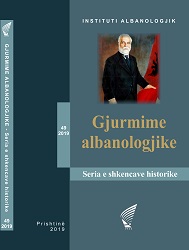KARAKTERISTIKAT E BAZILIKAVE ME TRI NEFE NË TERRITORIN E KOSOVËS
CHARACTERISTICS OF THREE AISLED BASILICAS IN THE TERRITORY OF KOSOVO
Author(s): Zana HoxhaSubject(s): Christian Theology and Religion, Architecture, History of Church(es), Local History / Microhistory, Middle Ages, History of Art
Published by: Instituti Albanologjik i Prishtinës
Keywords: basilica; architecture; Christianity; early Middle Ages; archeology;
Summary/Abstract: Based on the historical facts known to this day it is clear that Early Christianity in the territory of Dardania was at the point where ecclesiastical organization and structure was needed. Moreover, the need to accommodate such a group of people coming into the presence of God was clear. In addition to meeting the needs of believers as a gathering place, early medieval Christian architecture has special characteristics. The most typical buildings of this period throughout the world, as well as on the territory of Kosovo, are the basilicas. Basilicas are rectangular buildings, which are usually divided by columns in naves. The most common number of naves is three, but there are also spectacular basilicas with five, seven, or up to nine naves. This paper will analyze the basilica with three naves, with special focus on those on the territory of Kosovo. Based on current research and publications of archaeologists, a summary of this typology will be presented. This paper will include basilicas in Ulpiana, Harilaq, Studenica, Kastrc and the traces of the three-nave basilica in Pastasella. The analyzes carried out in these basilicas will serve to create a clear picture of this typology in the territory of Kosovo.
Journal: Gjurmime Albanologjike - Seria e shkencave historike
- Issue Year: 2019
- Issue No: 49
- Page Range: 73-87
- Page Count: 15
- Language: Albanian
- Content File-PDF

